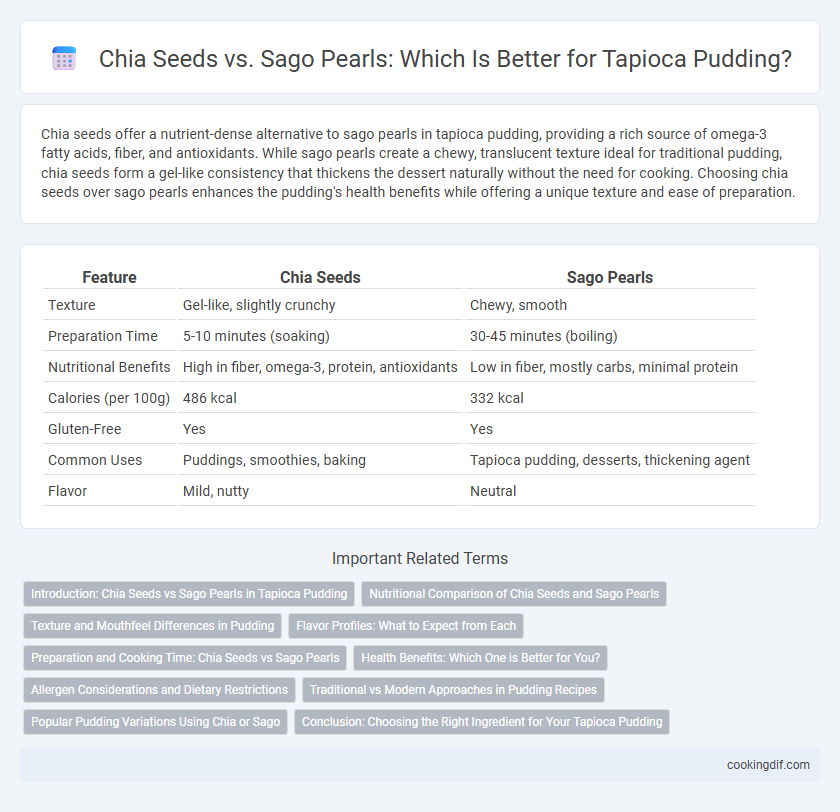Chia seeds offer a nutrient-dense alternative to sago pearls in tapioca pudding, providing a rich source of omega-3 fatty acids, fiber, and antioxidants. While sago pearls create a chewy, translucent texture ideal for traditional pudding, chia seeds form a gel-like consistency that thickens the dessert naturally without the need for cooking. Choosing chia seeds over sago pearls enhances the pudding's health benefits while offering a unique texture and ease of preparation.
Table of Comparison
| Feature | Chia Seeds | Sago Pearls |
|---|---|---|
| Texture | Gel-like, slightly crunchy | Chewy, smooth |
| Preparation Time | 5-10 minutes (soaking) | 30-45 minutes (boiling) |
| Nutritional Benefits | High in fiber, omega-3, protein, antioxidants | Low in fiber, mostly carbs, minimal protein |
| Calories (per 100g) | 486 kcal | 332 kcal |
| Gluten-Free | Yes | Yes |
| Common Uses | Puddings, smoothies, baking | Tapioca pudding, desserts, thickening agent |
| Flavor | Mild, nutty | Neutral |
Introduction: Chia Seeds vs Sago Pearls in Tapioca Pudding
Chia seeds and sago pearls offer distinct textures and nutritional profiles in tapioca pudding. Chia seeds absorb liquid quickly, creating a gel-like consistency rich in omega-3 fatty acids, fiber, and antioxidants, while sago pearls provide a chewy, translucent texture primarily composed of carbohydrates. Choosing between chia seeds and sago pearls depends on dietary preferences and desired pudding consistency.
Nutritional Comparison of Chia Seeds and Sago Pearls
Chia seeds offer a higher nutritional profile than sago pearls, providing a rich source of omega-3 fatty acids, fiber, protein, and essential minerals such as calcium, magnesium, and iron. In contrast, sago pearls are primarily composed of carbohydrates with minimal protein, fiber, or micronutrients, making them less nutrient-dense. The fiber content in chia seeds aids digestion and promotes satiety, while the high carbohydrate content in sago pearls mainly provides quick energy without significant nutritional benefits.
Texture and Mouthfeel Differences in Pudding
Chia seeds create a tapioca pudding with a gel-like texture characterized by small, tender beads that provide a slightly crunchy mouthfeel. Sago pearls yield a smoother, more uniform texture, offering a chewy and translucent consistency that melts gently in the mouth. The contrast between chia's subtle crunch and sago's resilient chew significantly impacts the overall sensory experience of tapioca pudding recipes.
Flavor Profiles: What to Expect from Each
Chia seeds offer a mild, nutty flavor with a subtle earthiness that complements the creamy texture of tapioca pudding, enhancing its natural sweetness without overpowering it. Sago pearls provide a more neutral taste with a slightly chewy texture, allowing the pudding's flavorings like coconut milk or vanilla to shine prominently. Expect chia seeds to add a delicate crunch and nutritional boost, while sago pearls deliver a traditional tapioca pudding experience with a smooth, gel-like consistency.
Preparation and Cooking Time: Chia Seeds vs Sago Pearls
Chia seeds require minimal preparation, only needing about 15-30 minutes to soak and absorb liquid before forming a pudding, making them ideal for quick, no-cook recipes. Sago pearls demand extensive preparation, typically involving soaking for several hours and boiling for 20-30 minutes, followed by cooling to achieve the desired tapioca pudding texture. The combined cooking and soaking time for sago pearls significantly exceeds that of chia seeds, impacting overall preparation efficiency.
Health Benefits: Which One is Better for You?
Chia seeds provide higher nutritional value than sago pearls, offering essential omega-3 fatty acids, fiber, and protein that support heart health and digestion. Sago pearls primarily consist of starch with minimal vitamins or minerals, making them less beneficial for sustained energy or nutrient intake. For a healthier tapioca pudding, chia seeds enhance the dish's antioxidant content and promote satiety compared to traditional sago pearls.
Allergen Considerations and Dietary Restrictions
Chia seeds offer a gluten-free and nut-free alternative to sago pearls, making them suitable for individuals with common allergies and gluten intolerance. Sago pearls, derived from the starch of palm stems, are also gluten-free but may pose risks for those with latex-fruit syndrome due to cross-reactivity. Both ingredients support vegan and paleo diets, but chia seeds provide additional omega-3 fatty acids and fiber beneficial for digestive health.
Traditional vs Modern Approaches in Pudding Recipes
Chia seeds offer a modern twist on traditional tapioca pudding by providing a nutrient-rich alternative with higher fiber and omega-3 content. Sago pearls remain the classic choice, prized for their chewy texture and authentic flavor synonymous with traditional pudding recipes. Incorporating chia seeds reflects contemporary health trends, while sago pearls preserve the cultural heritage of tapioca desserts.
Popular Pudding Variations Using Chia or Sago
Chia seeds create a nutrient-rich tapioca pudding variation with a gel-like texture and high fiber content, appealing to health-conscious consumers. Sago pearls offer a traditional chewy consistency, commonly used in Asian desserts for their light and translucent appearance. Both ingredients serve as popular starch sources, allowing diverse pudding recipes that cater to different texture preferences and dietary needs.
Conclusion: Choosing the Right Ingredient for Your Tapioca Pudding
Chia seeds provide a nutritious boost with high fiber and omega-3 fatty acids, making them a healthy alternative in tapioca pudding. Sago pearls offer the traditional chewy texture and subtle taste essential to classic pudding recipes, preserving authenticity and mouthfeel. Selecting between chia seeds and sago pearls depends on whether you prioritize health benefits or traditional texture in your tapioca pudding.
Chia seeds vs Sago pearls for tapioca pudding Infographic

 cookingdif.com
cookingdif.com